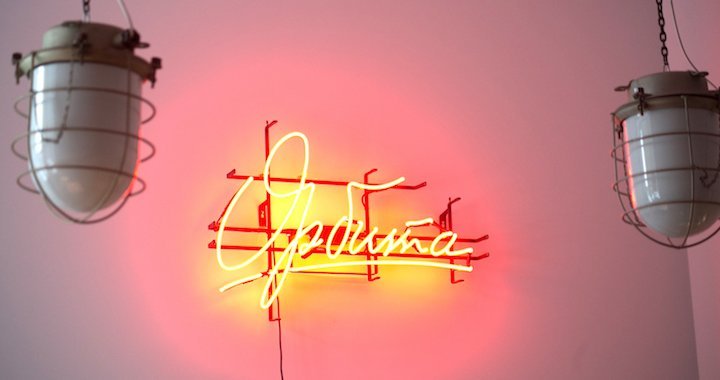
Reason to create
A conversation with members of the Orbīta text group - Aleksandrs Zapoļs, Sergejs Timofejevs, Artūrs Punte and Vladimirs Svetlovs - shortlisted for the Purvītis Prize 2019
Ilva Skulte
11/04/2019
Orbīta text group was founded in 1999, bringing together five Latvian poets writing in Russian – Aleksandrs Zapoļs, Sergejs Timofejevs, Vladimirs Svetlovs, Artūrs Punte and Žoržs Uaļļiks. 2019 sees Orbīta text group mark its twentieth anniversary, and the members of the group – both working as a collective and individually – continue to surprise with their sophisticated and original work in literature and publishing, as well as in contemporary visual and sound art. In recent years, alongside their collections of poems and photography, it is in the contemporary art life that the presence of Orbīta group has been particularly noticeable: no serious festival has gone by without their contribution. Projects like Riga Poetry Map (2014), the Radio Wall installation at KUMU museum of art as part of the 16th Tallinn Print Triennial (2014), Two Sonnets from Laputa as part of the Ornamentalism. The Purvītis Prize. Latvian Contemporary Art exhibition at the collateral programme of the Venice Biennale (2015) and Actual Spacescape at Cēsis Festival of Art (2016) demonstrate the particular interest of the members of the group in subjects that can be explored at the intersection of media and art. And it is probably the contemporary art scene that is the most open to similar experiments. So it seems only natural that the Where Do Poems Come From? exhibition by the Orbīta text group, presented early summer at the Noass Gallery, is among the works nominated for this year’s Purvītis Prize. In this exhibition, which was part of the parallel programme of the Riga International Biennial of Contemporary Art, the members of the Orbīta group had decided to look around for answers to the frequently asked and quite trivial question: Where do poems come from? Where and how are poetic texts born? Is it the result of mechanic construction or something more like a chain of revelations? Entropy of creation or the rhythm of disintegration? Is it something in the atmosphere or a certain state that you can enter and later leave again?

Aleksandrs Zapoļs. Where Do Poems Come From? / From Chaos Organization. 2018. Interactive aerodynamic poetic installation. To organize the chaos, elements of collective creativity and man-made wind are drawn in. Photo: Andris Priedīte
Your exhibition has been nominated for the Purvītis Prize as a collective work. From your point of view, is it authored by a collective or is it perhaps an amalgamation of a number of projects under the roof of a joint exhibition? What is the role of collaboration and dialogue in developing an idea, particularly considering that this conversation has been going on for twenty years now?
Aleksandrs Zapoļs: I work collectively.
Sergejs Timofejevs: The whole thing was quite simple, actually, because Dzintars Zilgalvis (director of the Noass Gallery – Ed.) defined the commission quite clearly – we had to mount a collective show. So we put our minds together and started to think about things we wanted to say and ways in which we wanted to do that. The process was collective up to the point where we agreed on the subject and the possible ways of approaching it. Then each of us started to look for his own answer to the question that we were asking with this exhibition: ‘Where do poems come from?’ This stage was the followed by interaction during the process of realization.
Artūrs Punte: In those cases when we are invited as a group, we, as often as not, understand our job as creating a certain modularity, so that each of us could contribute something of his own to the exhibited object – a poem or perhaps a whole work. For instance, in our Radio Wall project, which was also nominated for the Purvītis Prize back then, each of us was given a sector that he had to fill with his poems. We have to come up a new modularity niche every time.

Artūrs Punte and Jēkabs Vaļatovskis. Where Do Poems Come From ?/ From Pulsation. 2018. An acoustic electromagnetic string instrument for detecting the musical impulse source of poetry, allowing to separate poetic intonation and rhythm from the meaning of the words. Photo: Andris Priedīte
You mentioned that the Noass Gallery gave you a very clear brief for the assignment. It seems then that the concept of Orbīta as a collective is promoted by institutions that see you as this collective author?
Artūrs: We have previously said in interviews that the actual necessity to form a group was dictated by organizational reasons: we did not want to join any existing associations, like the Russian Section of the Writers’ Union or the Daugava Magazine – they were all either alien to us or inaccessible. That is how Orbīta was born, but as an author, each one of us has always existed separately.
Aleksandrs: We cannot be a single being…
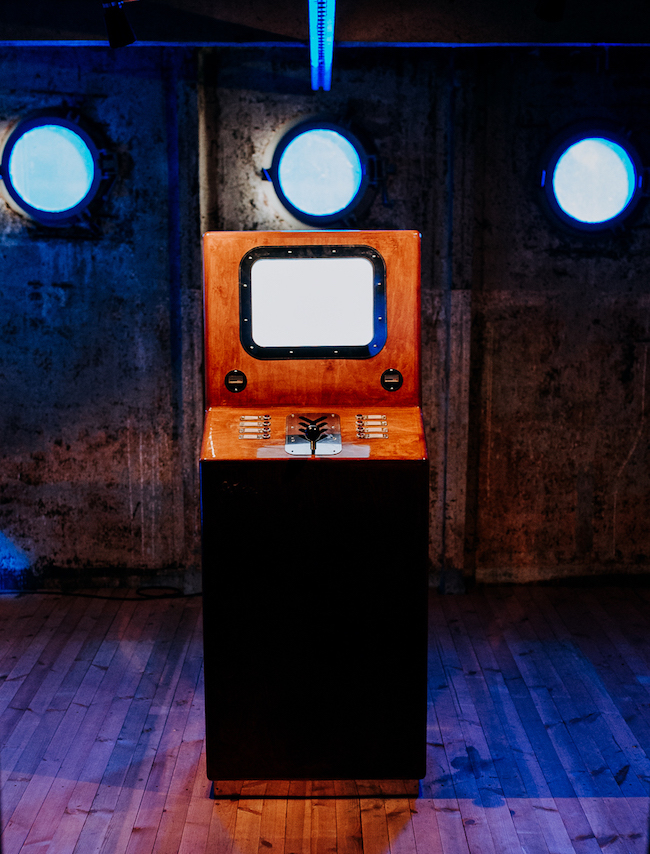
Sergej Timofejev. Where Do Poems Come From? / From the Window. 2018. A poetic machine that mixes recordings of four poems performed by four authors at their homes (in front of an open window going out into the street) with a single stationary video frame, serving as a way of ‘natural montage’ by means of changing reflections in the window. Photo: Andris Priedīte
Although there are examples of collective writing in the history of literature…
Aleksandrs: We have done that, as well – we wrote together for the electric fans (The Twinkling Crystal of Revelation object as part of the My Heart Is a Tiger exhibition at Dubulti Art Station). Actually, we have tried very different forms of interaction.
Vladimirs Svetlovs: We constantly consult with each other. The organization itself is a very primitive association, like a collective e-mail that endlessly repeats itself in ‘reply to all’, because we rarely manage to be at the same location at the same time.
Sergejs: On the other hand, when this e-mail has finally grown to a chain of some 30 letters and you start to forget what it was that started the whole thing in the first place – then we usually meet up and start all over again. I still think that the role of the institutions is that they offer us projects for the nearest future. We invent installations and objects to make in the future; we have ideas, but we do not discuss them as actual ideas for a specific project. The moment when we receive an offer to contribute to a festival or an exhibition is like a catalyst for the ideas that have been wandering around to assume a concrete form, to find an incarnation.
The title of the exhibition is a rhetoric question: where do poems come from? Why should it be answered and in what way?
Artūrs: It is a question always asked by students whenever poets are invited to visit schools. We wanted to capture a stereotype.
Sergejs: It was actually an attempt to give a possibly non-banal answer to a banal question.
Artūrs: Meaning that is was an attempt to answer the question that children usually ask without giving it any thought – the teacher says: ‘Question time!’, and they have to ask something.
Sergejs: And there is no collective answer to this question. There are different versions.
Aleksandrs: In any case, we could go on answering this question – specifically in the shape of installations and objects.
You believe then that this question about poems should not be answered textually but in the form of visually perceivable objects instead?
Aleksandrs: Visually, audially, any old way.
Artūrs: Interestingly, there were more answers. We were limited by space and other resources, but at the discussion stage, there were significantly more answers generated than shown.
Sergejs: We chose the best ones.
Artūrs: That remains to be seen.
But in what exactly were you interested in the context of this hackneyed question?
Artūrs: I would say we are interested in the existence of poetic text in other media.
Sergejs: I think that there is more to that. For instance, there is no text at all in Vladimirs’ work; the subject of his piece is a premonition of text, a state before text, before its coming into being. That is also an answer to the question. It is somewhat similar in my work where the poems come from a window – from a bit of your world and a bit of the world outside. Something structures itself. It is just that answers expressed through objects are more interesting or successful due to the potential variations of meaning.
Aleksandrs: I find it important that it is not a verbal answer. It sort of transfers the question to a different level and possibly expands the content.
Sergejs: The attempt was to make the exhibition as a certain answer, and even the titles of the works sort of respond to this ‘where do poems come from?’ – from pulsation; from the organization of chaos… That helped structure the exhibition as a statement.
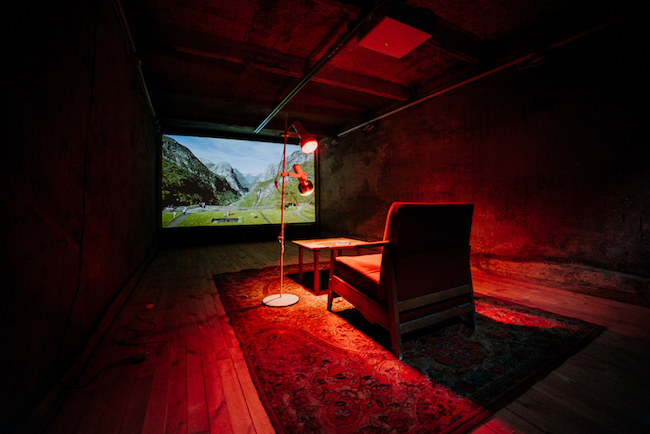
Vladimirs Svetlovs. Where Do Poems Come From? / From a Burrow. 2018. Spatial composition based on the ‘wormhole’ phenomenon. An attempt to reconstruct the situation that evokes an emotion preceding the appearance of a poem. Photo: Andris Priedīte
Does it mean that a banal question like this can be a signal that sets off an interesting stream of thoughts?
Artūrs: Well, yes, it is the beginning of an interaction with the audience, because you are asked – why Orbīta? It is important to give an informative answer and at the same time say something simply significant when you are answering a trivial question. So it turns out that we each have our own motives after all. I simply gave an answer that was about the part that interests me personally – the life of text in a non-textual medium.
Sergejs: Perhaps the question is not even that banal. It’s just that the direct answer to that is impossible to verbalise. Perhaps the question could be rephrased, asking, for instance: Where should we go looking for poems? What should we pay attention to?
Why is it in visual arts and not in literature that you are successful?
Artūrs: Back when [the translator and critic] Ieva Kolmane chaired the Writers’ Union, we were awarded the [Annual Latvian] Literature Award for a CD of poems. I think that it depends on how our work is viewed by professionals of each area. I am not sure if you can nominate a book for a prize in visual arts.
Vladimirs: I think that depends on the kind of book it is.
Artūrs: But I don’t know if they would consider an exhibition for a literature award. There is no category for such a nomination.
Vladimirs: That is once again a question of institutional limitations.
Artūrs: Everybody is preaching interaction, collaboration practice and multimediality but it has not been enshrined in practice; quite the opposite, in fact – specialisation is endorsed.
Sergejs: Also, it is so much more language-related in literature. It is important in which language the texts are written, how the language develops through these texts, how they further the language. Therefore clearly the focus in Latvian literature and particularly in poetry is on texts in Latvian. It is different in art; art is more abstract, and maybe that makes it easier to accept something and get interested in something.
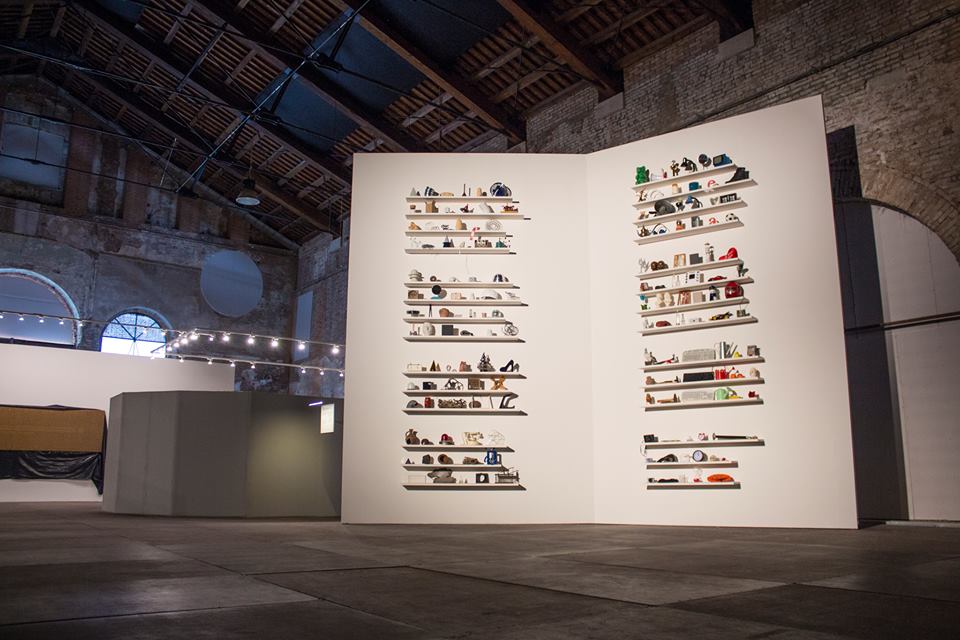
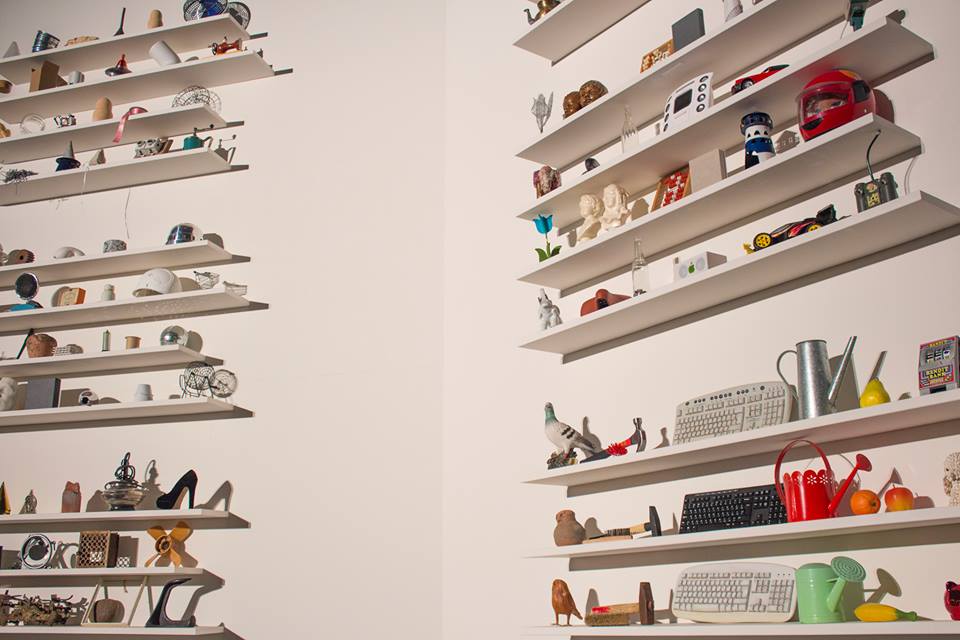
'2 sonets from Laputa’ at the ‘Ornamentalism. Purvītis Prize’ exhibition of Latvian contemporary art in Venice, at the 56th Venice Biennale
So you are interested in means of expression that are not limited by people’s command of languages.
Sergejs: I think that was exactly what our work Two Sonnets from Laputa was about. That was an attempt to find a universal language, to accept the world and objects in it as fragments of a poetic statement that we then exhibit arranged in a certain order to form a sonnet. That was a deliberate decision, and we debated quite a lot before making it, because we work a lot with language ourselves. The work was shown in Venice, a place where people from every corner of the world converge and speak in so many languages; and they should recognise and understand something, at least partially, so they would not be limited by the boundaries of a specific language.
Has the answer to the question of where do poems come from changed over the twenty years since you have been working as Orbīta group?
Vladimirs: It changed even during the short time while we were working on the exhibition, which was about a year. All sorts of ideas surfaced.
Aleksandrs: We are trying to find out ourselves.

Artūrs Punte and Aleksandrs Zapoļs. Photo: Viktorija Eksta
Is this answer influenced by any external factors – texts that you read, exhibitions that you view? To what extent this increasing ‘occupation earth’ has created ideas or made you move in a certain direction?
Aleksandrs: Your answers are not necessarily born from things you have read or viewed.
Sergejs: I think (but I may be mistaken) that this is a peculiarity we share – the multidiciplinarity of our sources of impressions. Everything matters to us – films, books, theatre; music also is very important.
Aleksandrs: Food.
Sergejs: Definitely! Everything works. Perhaps differently for each of us. Nevertheless, it is clear that we haven’t emerged from a single – literary, textual – environment.
Vladimirs: I think that it is not even possible today. That would be a very special case worth closer inspection.
Aleksandrs: Like Mowgli.
Vladimirs: Yes, a literary Mowgli. Quite unusual.
Aleksandrs: It would be interesting if an artist had grown up specifically on books.
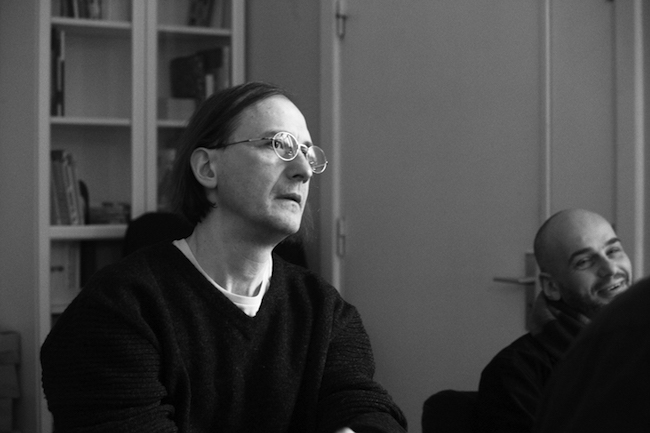
Vladimirs Svetlovs. Photo: Viktorija Eksta
Contemporary culture is a saturated and dense field. Do you have any sources of influence? Do you ever get a feeling that there are others who work in a similar manner to Orbīta?
Aleksandrs: There is a source, but we are not naming it because others might also turn to it.
Vladimirs: Perhaps the proverbial man in the shed.
Aleksandrs: I think that it is one of the nicest features of Orbīta that we do not have any idols. We still find our ideas in a sort of suspended emptiness.
Artūrs: The artist Anne-F Jacques caught my attention recently. She makes sophisticated sound objects out of anything she can lay her hands on – all sorts of trembling little wires etc. If I was an artist and was digging deeper, I would probably end up doing something like that. We have had our models, of course. NSRD (a seminal Latvian experimental musical group – Ed.) for instance, appeals to all of us with their freedom. I like very much when the material and technical nature of humanitarian phenomena is revealed. Technical manuals, the ancient formats of information media from the 1960s and 1970s to the present day. The information seems to be completely technical, and yet you look at it as a sort of house of ideas. All these things have been developed, invented, created for something to be incarnated in them. Everything is ready and handed to you on a silver platter – take it and use it! If I manage to embody in them a humanitarian idea, I find it very inspiring. But to each his own.
Vladimirs: We would indeed each come up with his own list of references. And it’s a good thing. The only thing, perhaps – if you want to find something that we all share – is our interest in the world of vintage objects. A somewhat melancholy interest in a bygone material culture. But again – maybe not everybody agrees. I was actually afraid – I did not have this kind of experience as an artist – that these references would be too obvious in my work, and I dreaded these comparisons. For the first time ever, I was genuinely afraid that I might be doing something that has been done before. Previously, because our statements were largely quite light- hearted and mischievous, this format of a jokey or not completely serious message relieved us of at least some responsibility. This time around, Dzintars specifically asked us to make a serious statement, and that put a great pressure on me.
Artūrs: Do you remember the feeling when we were getting ready for a performance with our Slow Show FM in Helsinki: we arrived at the museum and saw this radio tower (Babel (2001) by the Brazilian artist Cildo Meireles – Ed.). The idea was different and all that, and yet…
How can you find an original style of expression without being influenced by the world around you and yet make sense to the audience?
Aleksandrs: You have to do something as trivial as you possibly can, something that an artist would simply never do. It is true that we never lose certain naïveté. Since we are not completely professional artists, perhaps it adds certain freshness to our works – at least we hope so.
Sergejs: This sense of existing between various contexts also matters. We do not identify completely with the context of either literature or art. We are sort of outsiders everywhere. And it has its problems but there is also a bright side to it. It means that we also always have a different vantage point, a different approach. You could say that this is also a huge subject – this existence between different areas.
Artūrs: Not coincidentally, we have been invited to take part in a festival in Lithuania that is called Tarp, which means – ‘between’.
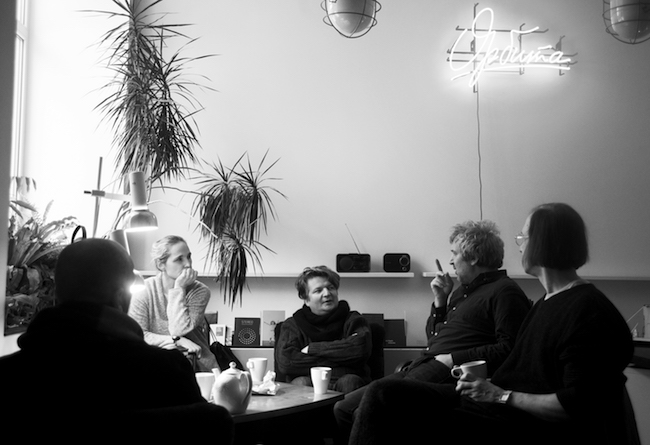
Photo: Viktorija Eksta
But what is this ‘between’ – how do you see it? ‘Between’ can be imagined as an empty space between two objects or people, or as something material – a thing, an idea or an intricate machinery. What is this ‘between’ for you – a thing, a binding agent or simply an idea of how communication could work?
Sergejs: Joy of perception.
Artūrs: Dialogue. I think that joy is in overcoming boundaries.
Actual Spacescape. Installation at the Cesis Art Festival (2016)
But what about the material? It does impose certain limitations and rules…
Artūrs: Overcoming the material presents all sorts of difficulties and problems for us.
Vladimirs: But it can also serve as an impulse – overcoming difficulties can stimulate.
Sergejs: Corporeity is important for us, but it is still secondary. The message, when it is first born, is not material. Then there is this wish to ‘release’ this subject into various media and see what happens then.
Artūrs: Unlike artists, we do not delve into material. We do not carry out in-depth research of its properties – with the exception of books. That is where we have prepared some ground, we have already made some excavations; there is a deep mine of personal experience. With other media, sometimes we don’t even familiarise ourselves properly with the material but still consider the work a success. That is what happened, for instance, with the fans at the Dubulti Art Station: they broke immediately after the opening of the show. Perhaps we should have focused on finding the problem and solving it – but I still think that it was quite a success. Because there was a dialogue, an interaction, albeit for a very short while. For a media artist who sees himself or herself as a contemporary sculptor, that would be a fiasco. In our case, it is still a good work.
Vladimirs: What matters to us is that the statement is made. We don’t quite understand why it should necessarily continue for three months or even for a month. Perhaps it’s a sort of poetic projection in that, as soon as you say something, a statement has already been made, and that is why many of our works have only existed for a day or even less.
Sergejs: Material for us is no more than a vehicle that constantly changes, constantly breaks down or stops being interesting for us. Yes, we never complete things really. Yes, we can simply go and abandon something really good. But that is justifiable – it just happens that way with us.
Artūrs: We could have simply settled into video poetry and go on as we started in 2001 with the festival – become respected video artists who use poetic texts. But we did not do that. We have no special relationship with material.
Sergejs: I would rather say there is a sort of pity we sometimes feel for a material. Artūrs, for instance, specifically felt sorry for fax machines, which have gone out of fashion, and this sentiment was used in our works at some point.
Vladimirs: There is this melancholy regarding objects as incarnations of ideas. Because we respect the media, the vehicles that are being phased out. There is this sentiment, perhaps even ecologism of the object world, which, as we all know, suffers from constant manufacturing and forcing out of the old by the new. It also seems that there is some sort of crisis of object-driven art going on. Institutions, museums that collect and restrict it – this also subjugates the artist, because he has to create objects for eternity. But working with ideas is much more interesting. The moment of translation is the pinnacle of the artwork.
Artūrs: There is something akin to poetry in this sentiment, where the most important thing is also the capturing of something fleeting in language – the instant of which the poet attempts to construct a text. Perhaps this is where these two things meet, these two passing nostalgias – poetry, technologies, media and this sentiment.
Aleksandrs: Whenever it happens that we start to get really good at something, whenever we end up with something polished and well-tried, we immediately abandon it. That is where our skill lies: if we start getting good at something, we must quickly give it up and start to exert ourselves to think up something new.

Photo: Viktorija Eksta